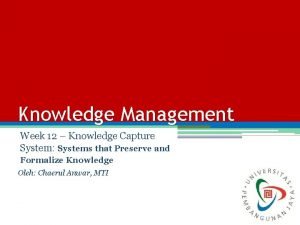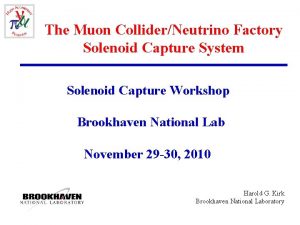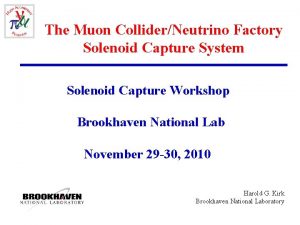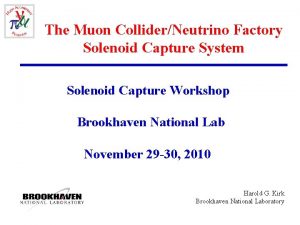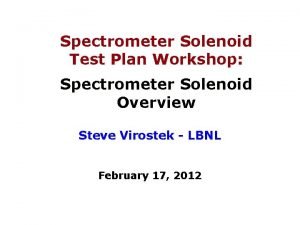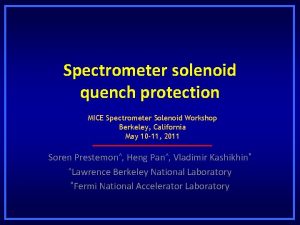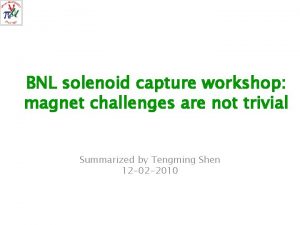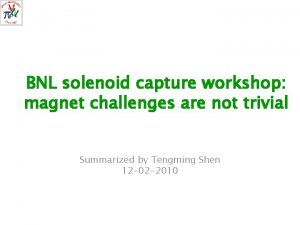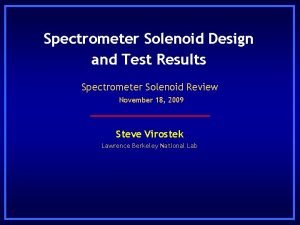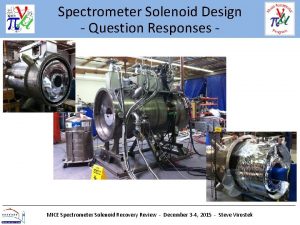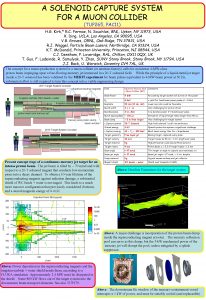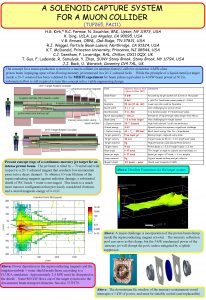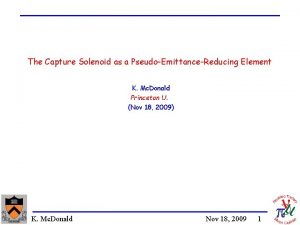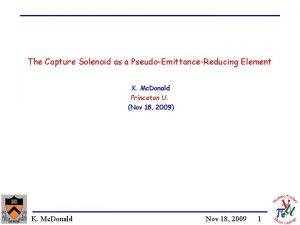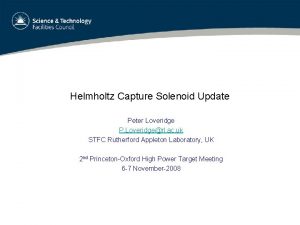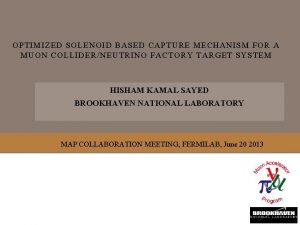The MC Solenoid Capture System Solenoid Capture Workshop
















- Slides: 16

The MC Solenoid Capture System Solenoid Capture Workshop Brookhaven National Lab November 29 -30, 2010 Harold G. Kirk Brookhaven National Laboratory

The Muon Collider Concept Key technical issues: Requires a multi-MW proton driver A production target system to produce copious pions A cooling system to reduce the phase space of the collected muons High gradient rf for rapid acceleration Harold G. Kirk 2

The Neutrino Factory The muons in a storage ring decay such that: μ+ e+ νe νμ and μ- e- νe νμ Further, the ν’s are projected forward with an opening angle ~ 1/γ. This gives rise to a very powerful ν beam capable of being projected over long baseline distances. Harold G. Kirk 3

Layout of a Neutrino Factory Harold G. Kirk 4

The Neutrino Factory Target Concept Maximize Pion/Muon Production l Soft-pion Production l High-Z materials l High-Magnetic Field Palmer, PAC 97 Harold G. Kirk 5

The Proton Beam Parameters Proton Beam Energy Rep Rate Bunch Structure Bunch Width Beam Radius Beam β* Beam Power 8 Ge. V 50 Hz 3 bunches, 320 sec total 2 1 ns 1. 2 mm (rms) ≥ 30 cm 4 MW (3. 125 1015 protons/sec) Harold G. Kirk 6

The Target System Target type Jet diameter Jet velocity Jet/Solenoid Axis Angle Proton Beam/Jet Angle Capture Solenoid Field Strength Free mercury jet 8 mm 20 m/s 96 mrad 27 mrad 20 T Harold G. Kirk 7

The NF Study 2 Target System Neutrino Factory Study 2 Target Concept Harold G. Kirk 8

Target System Exploded View All insertion/extraction from upstream end Locating & supporting features not shown – will require additional space Harold G. Kirk 9

MARS 15 Study of the Hg Jet Target Geometry Previous results: Radius 5 mm, θbeam =67 mrad Θcrossing = 33 mrad Harold G. Kirk 10

Multiple Proton Beam Entry Points p 0 Proton Beam Entry points p 12 jet p 4 Entry points are asymmetric due to the beam tilt in a strong magnetic field p 8 Harold G. Kirk Brookhaven National Laboratory Proton beam entry points upstream of jet/beam crossing

Optimized Meson Production X. Ding, UCLA Radius Previous baseline 0. 5 cm Beam Angle Previous baseline 67 mrad Beam/Jet Crossing Angle Previous baseline 33 mrad Production of soft pions is most efficient for a Hg target at Ep ~ 6 -8 Ge. V, Confirmation of low-energy drop-off by experiment (HARP, MIPP) highly desirable. Harold G. Kirk 12

Meson Production vs β* Meson Production loss ≤ 1% for β* ≥ 30 cm Harold G. Kirk 13

MARS Energy Deposition Studies SC 1 SC 2 SC 3 SC 4 SC 5 Air Fe. Co Hg Jet WC Shield Hg Jet Pre-Trgt STST Env (Bottle) Res Sol Hg Pool MARS 15 study of Study 2 configuration yields 38 KW energy deposition in SC 1 alone Be. Window (z=600 cm) Harold G. Kirk 14

Reconfigure SC magnets Increase the SC ID’s. Fill released volume with shielding. Total energy deposition in all SC’s reduced to ~4 k. W. But SC magnets around target are now extremely difficult. Details to be provided by N. Souchlas Harold G. Kirk 15

Key Target Challenges General Target Issues l Thermal management (~3 MW power deposited) l Shielding (SC Solenoids required) l Target integrity (Thermal Shock) l Target regeneration (50 Hz rep-rate) l 20 T environment Liquid Hg specific issues l Stable fluid flow (Nozzle performance) l Hg handling system Harold G. Kirk 16
 Knowledge capture system
Knowledge capture system Hát kết hợp bộ gõ cơ thể
Hát kết hợp bộ gõ cơ thể Frameset trong html5
Frameset trong html5 Bổ thể
Bổ thể Tỉ lệ cơ thể trẻ em
Tỉ lệ cơ thể trẻ em Voi kéo gỗ như thế nào
Voi kéo gỗ như thế nào Tư thế worm breton là gì
Tư thế worm breton là gì Alleluia hat len nguoi oi
Alleluia hat len nguoi oi Các môn thể thao bắt đầu bằng tiếng chạy
Các môn thể thao bắt đầu bằng tiếng chạy Thế nào là hệ số cao nhất
Thế nào là hệ số cao nhất Các châu lục và đại dương trên thế giới
Các châu lục và đại dương trên thế giới Công thức tính độ biến thiên đông lượng
Công thức tính độ biến thiên đông lượng Trời xanh đây là của chúng ta thể thơ
Trời xanh đây là của chúng ta thể thơ Mật thư tọa độ 5x5
Mật thư tọa độ 5x5 Phép trừ bù
Phép trừ bù độ dài liên kết
độ dài liên kết Các châu lục và đại dương trên thế giới
Các châu lục và đại dương trên thế giới
